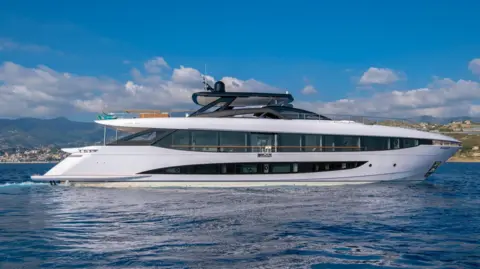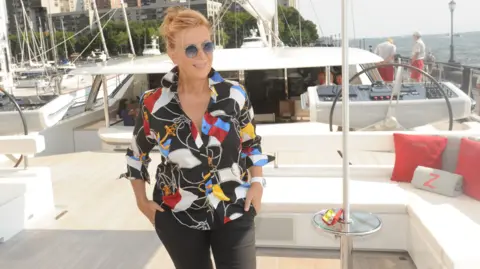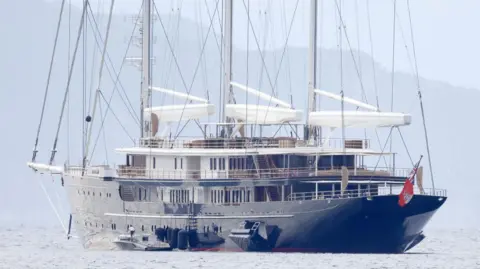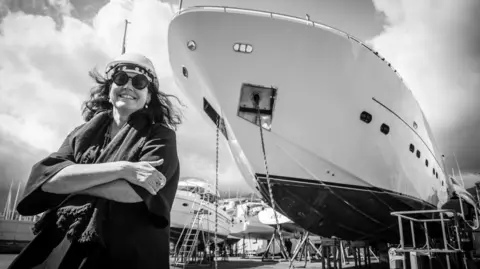Why the world's superyachts are getting bigger and bigger
 Amer
AmerBusiness is booming in the luxury world of superyachts, with the super-rich wanting ever bigger floating palaces.
Paola Trifirò knows a thing or two about superyachts – she and her husband have owned more than a dozen over the years.
The Italian couple, who have made their fortune in law, and continue to run a global legal firm, like to sail around the world in the height of luxury.
Ms Trifirò describes their boats, which can be more than 50m (164ft) long, as being like floating five-star hotels. And she likes to get involved in the design process.
One criteria she insists upon is that the crew have ample kitchen space, so they can cook gourmet meals for up to 15 people.
Ms Trifirò explains her reasoning: "If you are used to eating well, not everywhere [in the world] are there restaurants good enough."
She also says that the large size of the vessels is reassuring. "Whether it's sailing alongside humpback whales, or receiving greetings by fishermen on the Fiji islands, my boats allow me to sail… with strength and safety."
 Paulo Trifirò
Paulo TrifiròBut what exactly is a superyacht? While there is no official global classification, industry website and magazine Boat International describes one as "a luxury, privately-owned yacht that measures 24 metres or more in length, and is professionally crewed".
The magazine says that global sales boomed after Covid. With the super rich suddenly unable to go to luxury hotels, as they were all closed during the pandemic, many switched to superyachts instead.
As a result, 1,024 new superyachts were built or on order around the world in 2022, a 25% jump from 2021, and a then all-time high, according to Boat International's figures. This then increased to 1,203 in 2023, another new record.
"After the pandemic people considered their super yachts as safe islands both for themselves and their relatives," says Barbara Armerio who co-owns Italian family-run superyacht builder Amer.
She adds that billionaires cherished their personal space and independence even more. "They asked for bigger windows, more space outside, and to be able to touch the seawater more easily".
While the overall number of superyachts being built or ordered is expected to fall slightly this year to 1,138, they are getting bigger on average, Boat International's data also shows. So far this year, 61 boats of 76m or more in length are being made, up from 55 in 2024.
And in the 46m to 60m grouping, numbers have increased to 175 from 159. Meanwhile, sales of the smallest superyachts, between 24m and 27m are down to 286 from 321.
"It's clear that some of those new clients the industry found in the Covid-19 years are trading up," says Ms Armerio.
Boat International's editor in chief Stewart Campbell says that whatever size superyacht people buy "designers and naval architects are getting very clever at packing ever more volume into hulls, giving owners lots more space on board".
As a result, today's superyacht's increasingly have everything from helipads to cinemas, gyms, beauty salons, and saunas.
 Getty Images
Getty ImagesAs you'd imagine, prices are extremely high. You can pay €36m ($41m; £30m) for a new smaller boat, up to €295m for a 105m-long vessel with all the optional extras.
Half of all superyachts continue to be built in Italy, with its yards currently working on a combined length of 22,195m, or approximately 22km (13 miles), of boats. Turkey is in second place, followed by the Netherlands, the UK, Taiwan, Germany, the US and China.
Back in 2023, Italian shipbuilders earned €8.3bn from making superyachts, a record high.
Ms Armerio says her shipyard "produces only a few high-grade" superyachts per year, "masterpieces with unique details".
She adds that Italian yacht-makers like hers are supported by a solid network of local artisans. "In Italy we find everything we need."
Ms Armerio points to being able to drive to Tuscany's stone quarries from her company's base on the coast of Liguria if she needs to order marble.
 Barbara Armerio
Barbara ArmerioRegarding the billionaires and multimillionaires who buy superyachts, Boat International says that most are from the US. Yet it points to more coming from Turkey, Indonesia and Mexico as those countries' economies grow.
Meanwhile, sales to Russian buyers have fallen to due to the sanctions against the country and its elites as a result of Russia's invasion of Ukraine.
If the appeal of a superyacht wasn't immediately obvious, Ms Trifirò says they enable her to see the world and fulfil her wanderlust. And she likes to be at the controls of the boat.
"My curiosity to explore new places pushes me to cruise the oceans while in the driver's seat," she says.
Ms Trifirò adds that her crew is paid double what they'd likely earn on land "as it is very important to keep them happy. Our captain has worked for us for 22 years."
